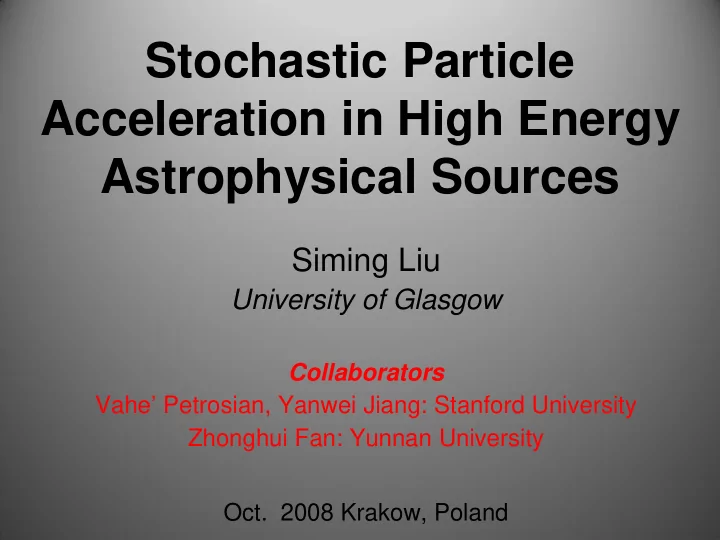

Stochastic Particle Acceleration in High Energy Astrophysical Sources Siming Liu University of Glasgow Collaborators Vahe ’ Petrosian, Yanwei Jiang: Stanford University Zhonghui Fan: Yunnan University Oct. 2008 Krakow, Poland
Outline I: Observations: Distribution II: Mechanism: Fermi Acceleration III: Shock Model IV: Observations: Acceleration Efficiency V: Stochastic Particle Acceleration Model VI: Conclusions
I: Discovery of Cosmic Rays Victor Franz Hess 1912
I: Birth of Radio Astronomy Karl Jansky 1933 Grote Reber 1944
II: Fermi Mechanism Particles interact with Macroscopic objects Electro-Magnetic Interaction But not collisional
III: Shock Model 11/1/2008 6
III: Shock Model • Scattering Mechanism • Injection Problem or Particle Acceleration at Low Energy Wave Particle Interactions!!! 7
IV: Acceleration Efficiency
IV: Solar Energetic Ions
V: Free Energy Dissipation and Turbulence
V: Turbulence Cascade • Kolmogorov • Kraichnan U(L) V>U U 3 (L)/L = constant U 4 /LV = constant k~1/L U(k) ~ k -1/3 U(k) ~ k -1/4 ʃ E(k) dk~ U^2(k) ~ k -2/3 ʃ E(k) dk~ U^2(k) ~ k -1/2 E(k) ~ k -5/3 E(k) ~ k -3/2
V: Diffusion Approximation Cascade Damping Suppression of turbulence cascade by wave propagation ʃ W(k) k 2 d Ω ~ E(k) Jiang et al. 2008
V: Dispersion Relation Fast Modes Alfven Modes
V: Wave Damping (WHAMP Code) He-cyclotron p -Landau e -Landau
V: Alfven Wave Cascade W -7 / 2 k 9 9 9 9 t t t t 3 3 3 3 . . . . 65 70 46 40 10 10 10 10 p p p p
V: Turbulence Cascade Dispersive Effects τ W ω(k) -1 = 1 V g . k W MHD regime
V: Damping Effects Jiang et al. 2008
V: Turbulence Cascade and Damping
V: Turbulence Cascade and Damping Observation: (Leamon et al. 1998) Simulation: (Jiang et al. 2008)
V: Dispersion Relation
V: Electron-Whistler Resonance
V: Dispersion Relation Fast Modes Alfven Modes
V:3He vs 4He
V: 3He vs. 4He
V: A Complete Treatment of Stochastic Acceleration and Plasma Heating Jiang et al. 2008
V: A Complete Treatment of Particle Acceleration in Magnetized Dissipative Plasmas Acceleration by Large Scale Structure Shock Waves Electric Fields Jiang et al. 2008
Observations HESS Slide 27
Challenges to the Hadronic Models No thermal X-rays Egret upper limit SNR RX J1713.7-3946 1 Suppression of Electron Acceleration 4 Hard Spectrum with p<2.0 2 High Energy & 3 Density Requirement Tanaka et al. Slide 28
Challenges to the Hadronic Models Tanaka et al. Slide 29
Challenges to the Hadronic Models 6 Lack of Correlation between TeV and Cloud Distribution: Plaga Slide 30
Challenges to the Leptonic Models 1: TeV spectrum too narrow: Background photon? Porter et al. Tanaka et al. Slide 31
Challenges to the Leptonic Models Uchiyama et al. 2007 2: Weak B field: Variability? Tanaka et al. Slide 32
A New Paradigm for Collisionless Shocks Lee et al. 1994 Slide 33
Speed Profiles in the Downstream Slide 34
Turbulence spectrum Slide 35
Electron Acceleration by Fast Mode Waves Slide 36
Spectral Fit to SNR RX J1713.7-3946 Slide 37
The Nature of the SNR Shock Slide 38
X-ray Variability Uchiyama et al. 2007 Slide 39
VI. Conclusions Plasma Wave Turbulence is an important channel for the release of free- energy in high energy astrophysical sources Stochastic Acceleration by it can lead to a quantitative treatment of plasma heating and acceleration of non-thermal particles
Recommend
More recommend